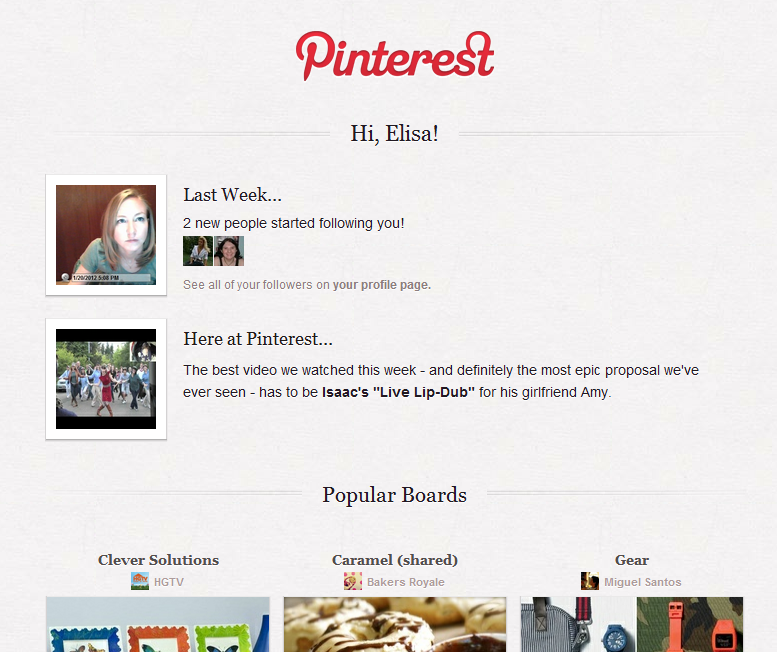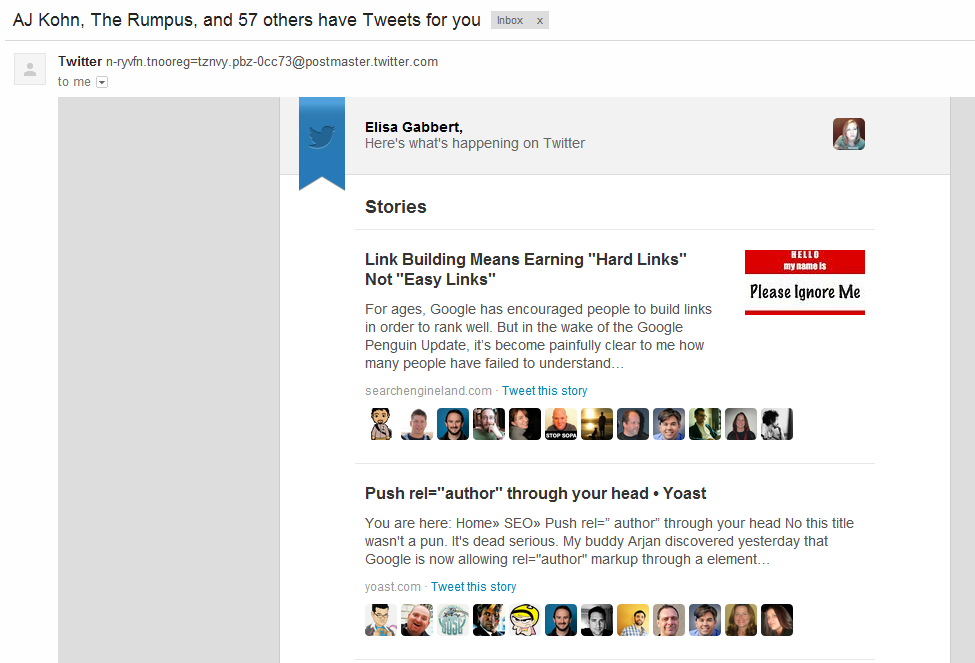Twitter, bless their hearts, tends to be a bit slow to catch on compared to other social networks. It has been around for about six years, but Twitter has been quite sluggish in adding new features and enhancing its website’s functionality. For instance, it took them years to create a “retweet” button (and the way they introduced it initially was not well received); they bought TweetDeck in May 2011, but have kept it as a separate app with its own brand instead of incorporating those great features into Twitter itself.
About a month ago, Twitter emailed users to share some updates and policy changes. The first change announced was a “new weekly email” that will provide the most interesting news and items you may have missed from the accounts you follow on Twitter. I would bet this is a reaction to Pinterest, the rapidly growing social platform that keeps users hooked and is very appealing to marketers. Pinterest regularly sends out emails notifying you of new followers, trending boards, and suggesting pins you may enjoy.

This is obviously a good engagement driver, and clearly someone at Twitter was smart enough to figure that out and think, “Hey! Maybe we should be doing this!” And now they are. It looks like this:
The email highlights both articles that got shared a lot via Twitter (with links to the original source plus a direct link if you want to “Tweet this story”) as well as tweets that got a lot of favorites and RT’s:
I will not be unsubscribing from this email, as I do with so many emails I get from companies after registering for a service (looking at you, Klout) or to make a purchase on an e-commerce site. I like it as a user, and I like it even more as a marketer. Here are some of the reasons I think this is well done:
- It appeals to my FOMO (fear of missing out) – Even though I’m on Twitter almost every day, I still miss a lot – when I’m cooking, sleeping, at the gym, out with friends or doing anything that doesn’t involve sitting in front of a computer. (Admittedly, I’m sitting in front of a computer for huge chunks of my life, but I don’t use Twitter on a mobile device, so I do miss stuff when I’m not at home, and I don’t have the time or inclination to try to catch up on what I may have missed.) This new email highlights some popular tweets from the previous week, going a step further than the “Activity” tab to let me know what my friends and followers are paying attention to. Much like the shared items in the old, social version of Google Reader (RIP), those are often the items you want to go to first.
- Great use of subject line – The above email arrived in my inbox with the subject line “AJ Kohn, The Rumpus, and 57 others have Tweets for you.” I love the specificity of this compared to the last email I got from Pinterest, which was “Your Pinterest Recommendations” – a boilerplate, generic subject line. Other emails I’ve gotten from Pinterest came with the subject line “This Week on Pinterest.” I don’t think it’s wise to use the same subject line every week. Some people don’t open every email they get; you need to entice them with something that will speak to their personal interests. Twitter’s email catches my eye with the name recognition of two accounts that I follow and that other people I follow follow as well.
- This is no-harm-no-foul marketing – It’s not trying to sell me anything, it’s just driving traffic to the site. This is why it’s a great idea to send out a weekly/biweekly/monthly email that simply alerts interested readers to recent content on your site or blog, the stuff that they probably genuinely don’t want to miss. See the SEOmoz Top 10 or our own Performance Tip, which promotes a single recent blog post we think our subscribers will find helpful.
- It practically runs itself – From a marketing perspective, a regular email like this is incredibly easy to put together. You don’t need a million-dollar copywriter to craft a unique message every week; you don’t need to figure out something to offer and build a unique landing page and form to capture leads or sales. It’s formulaic and 90%+ of the content is either user-generated or just repurposing content you’ve already written for your blog or site. Once you’ve created a template for the email, you can spin it out with very little effort every week.
What do you think of Twitter’s new weekly email? Has it increased your engagement with the site?

